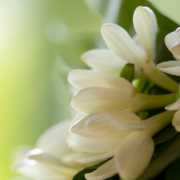The Symphony of Plants’ Communication
The Rich Repertoire of Aromatic Languages
Table of contents
-
The Aria of the Flora
-
The Alchemy of Imitation
-
Plants’ communication: a rich repertoire of aromatic languages
-
Understanding Plant Olfactory Receptors
-
The Covert Garden Symphony
The Aria of the Flora: An Orchestra of Nature’s Silent Performing Arts
In the grand tapestry of terrestrial existence, one might easily neglect the ostensibly quiet and motionless denizens of the botanical realm. To the untrained eye, the plant world may seem serene and uneventful. However, beneath this placid veneer, these verdant heroes orchestrate an intricate symphony of communication, weaving a language of fragrances and a choreography of survival tactics. We may title his opus “The Aria of the Flora”.
Chapter 1: The Fragrant Declarations
Plants, the oft-undervalued entities within our ecosystem, have evolved an astonishing array of stratagems to secure their survival. Among the most extraordinary is their capability to generate and emit scents. While humans primarily perceive these aromas as merely pleasant or offensive, plants use them as a crucial communication medium. The interplay between flora and insects is pivotal to their survival, with their shared lexicon being fundamentally chemical—the perfume.
In the botanical world, methyl jasmonate is a prevalent aromatic compound produced by numerous species, fulfilling an extraordinary role—it acts as a natural insect deterrent. Analogous to our use of repellents to thwart mosquitoes at a summer gathering, plants leverage the potency of scent to dissuade unwelcome intruders. Yet, the subtleties of this communication extend beyond mere pest deterrence. Occasionally, plants emit fragrances that mimic their adversaries, thereby perplexing or deterring them. These aromatic molecules function akin to hormones in animals, influencing not only the behavior but also the internal chemistry of the recipients.
Chapter 2: The Alchemy of Imitation
Nature is a virtuoso of imitation, and plants are no exception. Just as some animals mimic others for survival, plants can replicate the scents of their adversaries to fend off potential threats. This mimicry transcends the insect domain. In the intricate ballet of predator and prey, plants have devised ingenious solutions. When a particular worm besieges maize, it releases aromatic molecules that serve as a distress signal, summoning the predators of these attackers. This exemplifies how, in nature, every conundrum yields a resolution.
However, mimicry is not solely defensive. Specific orchids elevate it to an art form. These cunning plants produce blossoms that closely resemble female wasps. The enchantment lies not in their appearance but in the aromatic compound they emit—an exact replica of the female wasps’ sexual pheromone. Male wasps, irresistibly drawn to this fragrance, attempt to “mate” with the flower, thereby becoming inadvertent pollinators. This showcases the ingeniousness of the Creator of plants in the realm of mimicry and seduction.
Chapter 3: Plants’ communication. A rich repertoire of aromatic languages
Plants’ communication is not confined to insect interactions. They possess a rich repertoire of aromatic languages to converse with each other and their surroundings. This suggests that plants must have the capability to perceive and interpret these scents. Indeed, they do. Even the most primitive plants possess an impressive array of olfactory receptors, far surpassing the few hundred humans possess. This extensive olfactory arsenal allows them to decipher the myriad scents drifting through the air, unveiling a world of communication hidden from our senses.
The rationale behind using aromatic molecules as a communicative medium is clear. Unlike animals, plants cannot vocalize or gesture. They rely on the wind to carry their ‘voice’ or ‘song’ to other plants. Additionally, they can exchange chemical signals through the soil. The structure of these aromatic molecules is remarkably similar to pheromones, endowing them with the power to induce changes in the behavior or physiology of the recipient, much like hormones in animals.
Chapter 4: Understanding Plant Olfactory Receptors
1. Plants, often underestimated in their sensory capabilities, possess a complex system for detecting and responding to chemical signals in their environment. Central to this system are plant olfactory receptors—specialized proteins that allow plants to “smell” or detect volatile organic compounds (VOCs) in the air.
Plant olfactory receptors are part of a broader group of proteins known as chemoreceptors, which detect chemical stimuli and initiate signaling pathways that lead to specific physiological responses. Unlike animals, where olfactory receptors are typically found in the nasal epithelium, plant olfactory receptors are distributed throughout various tissues, including leaves, roots, and even flowers.
2. Detection of Volatile Organic Compounds (VOCs)
Plants emit and detect VOCs, which serve as signals in a variety of interactions—such as attracting pollinators, deterring herbivores, or signaling other plants about environmental stressors. Research has shown that plants can detect VOCs produced by neighboring plants, allowing them to respond to threats such as herbivory or pathogen attacks. For example, when a plant is attacked by an insect, it may release VOCs that neighboring plants detect through their olfactory receptors, prompting them to preemptively bolster their defenses.
3. Scientific Evidence
Recent studies have provided strong evidence supporting the presence and function of these olfactory receptors in plants:
-
Study on Arabidopsis thaliana: Arabidopsis, a model organism in plant biology, has been found to possess numerous genes encoding receptors similar to animal olfactory receptors. Research published in Nature Communications highlighted that these receptors enable the plant to detect specific VOCs, triggering downstream signaling pathways that lead to defensive responses.
-
Maize and Herbivory-Induced Volatiles: A study in Plant Physiology demonstrated that maize plants could detect VOCs released by nearby plants infested with herbivores. The detected signals, perceived through olfactory receptors, led to the expression of defense genes in the maize plants, increasing their resistance to the same herbivores.
-
Grapevines and Powdery Mildew: In another study, grapevines exposed to VOCs from neighboring plants infected with powdery mildew showed increased resistance to the disease. This response was mediated by olfactory receptors that detected the VOCs and initiated a protective signaling cascade.
4. Mechanism of Action
The mechanism through which plants detect VOCs via olfactory receptors involves a signal transduction process similar to that in animals:
- Binding: A VOC binds to an olfactory receptor on the surface of a plant cell.
- Signal Transduction: The binding triggers a cascade of intracellular signals, often involving secondary messengers like calcium ions or reactive oxygen species.
- Gene Expression: This signal transduction ultimately activates or represses specific genes that control the plant’s physiological response, such as producing defensive chemicals or closing stomata to reduce water loss.
5. Implications and Future Research
The discovery and understanding of plant olfactory receptors have profound implications for agriculture and ecology. By manipulating these receptors or the signals they detect, scientists could develop crops that are more resistant to pests or better adapted to environmental stressors. Additionally, understanding these mechanisms could lead to innovations in pest management, reducing the need for chemical pesticides.
Future research is likely to focus on identifying the full spectrum of olfactory receptors in various plant species, understanding the specific VOCs they detect, and exploring how these receptors evolved across different plant lineages. This research could also extend into synthetic biology, where engineered plants with enhanced olfactory receptors could be designed for specific agricultural purposes.
In conclusion, plant olfactory receptors represent a fascinating and relatively underexplored aspect of plant biology. They provide insights into how plants interact with their environment and offer potential avenues for biotechnological applications.
Chapter 5: The Covert Garden Symphony
In nature’s covert garden, plants are the composers and conductors of a silent symphony, a communication network built upon fragrant notes. This language has evolved over eons, a dialect of survival, seduction, and cooperation.
In this verdant orchestra, plants produce aromatic molecules that serve as signals—sometimes to repel, sometimes to mimic, and sometimes to beckon. The complexity of this system is a testament to the remarkable adaptations that have enabled plants to flourish in an ever-changing world.
The next time you traverse a meadow or forest, remember that the fragrances you perceive are not merely delightful olfactory experiences; they are conversations among the plants themselves, a symphony of survival, and a testament to the beauty and intricacy of the natural world. As we delve deeper into the enigmas of this green communication, we uncover that the “aria of the flora” is a melody of life itself, a harmonious testament to the marvels of the natural world.
The Rich Repertoire of Aromatic Languages

























Leave a Reply
Want to join the discussion?Feel free to contribute!